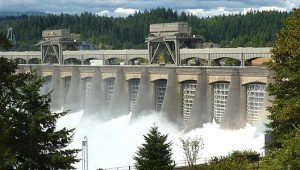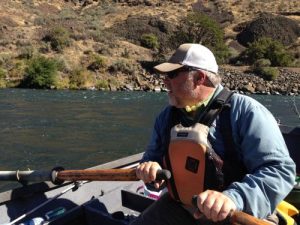
Bonneville Dam
Editor’s Note: Our Conservation Chair, Dave Moskowitz, provides us with the latest data on salmon and steelhead runs on the Columbia. Please take the time to read his notes that include caveats related to the numbers and policy (or lack thereof). Thanks Dave for sharing this vital, albeit depressing, information for the conservation-minded fly fisher. LKH
Here is a current snapshot of the 2018 migration as of June 15, 2018 for spring chinook and sockeye, as well as an update on the forecasts for summer steelhead into the Columbia and Snake Rivers.
Current Fish Counts at Willamette Falls and Bonneville Dam
Willamette Falls Fishways at Oregon City, OR (as of June 20, 2018)
- Spring Chinook: 20,329 total adult spring chinook, of which only 3,763 are wild/unclipped (meaning wild springers comprise 18.5% of the total passage of spring chinook)
- Wild Winter Steelhead Passage: 1,829 adults which is 19.3% of the 50-year average (9,486) and 36% of the most recent ten-year average (5,152). Winter steelhead are counted from November 1 to May 31. For some magical reason wild winter steelhead stop returning on May 31, even though 173 “unclipped” summer steelhead have passed the Fishways during the first 20 days of June.
- Non-native hatchery summer steelhead: 6,033 adults (from March 1 – June 20) passed the falls Hatchery steelhead smolt releases averaged 626,853 fish between 1989 and 1998.
- Spring Chinook Catch (Willamette only) is at 5,878 kept fish with 1,153 wild chinook released (likely resulting in mortality for 115 wild fish, using ODFW’s 10% release mortality estimates).
- Steelhead Catch (wild winter and Non-native hatchery summer in the lower Willamette and Clackamas) is 537 fish kept and 179 released (with estimated 18 wild steelhead mortalities).
- ODFW estimates that marine mammals consume approximately 25% of the steelhead and 7% of the spring chinook that reach the fishways, which could mean that the predation mortality at Willamette Falls is approximately 3,388 adult steelhead and salmon.
- Combining catch and predation, mortality on spring chinook and steelhead in the lower Willamette is likely 9,936 fish.
Bonneville Dam on the Columbia River:
- Chinook are counted as “spring” fish from January until June 15, and “summer” chinook from June 16 through July 30.
- Spring chinook: 108,045 adults which is 58% of the most recent ten-year average (185,222).
- The pre-season forecast for upriver spring chinook was originally 166,700 spring chinook.
- The in-season update from the Technical Advisory Committee was 116,500 spring chinook (a 30% reduction in forecast, and the actual spring chinook return came in only 65% of the original prediction.
- Spring chinook jacks (precocious males): 7,563 fish (23% of the recent ten-year average -32,670)
- Sockeye: 120,577 adults which is 51.4% of the most recent ten-year average (234,788).
2018 Winter Steelhead / Early Summer Steelhead: as of June 28, 2018
- Total 2018 steelhead: 7,121 total hatchery and wild fish which is 49% of the most recent ten-year average of 14,583 fish (winter and early summer steelhead from January 1 thru June 30).
- Wild Winter and Early Summer Steelhead: 3,006 wild fish which is 59.2% of the most recent ten-year average of 5,077 fish (January 1 thru June 30).
- Early Summer Steelhead only (returning April 1 thru June 30): 5,444 total hatchery and wild fish (44.3 % of the ten-year average of 12,281 total hatchery and wild steelhead).
- Early summer wild steelhead (returning April 1 thru June 30): 2,327 fish (only 55.2% of the most recent ten-year average of 4,213 wild fish).
2018 Summer-Fall Forecasts for Columbia and Snake River Wild Steelhead
- Early Summer Steelhead (so-called “Skamania stock”) are forecast at 7,950 total hatchery and wild fish. These fish will return to rivers below and above Bonneville Dam, and their run year is considered from April 1 thru June 30). The wild component is predicted to be 3,000 wild fish (only 1,236 wild early summer steelhead passed Bonneville Dam in 2017).
- A-run wild summer steelhead past Bonneville Dam are forecast at 48,200 fish for the entire Columbia and Snake River basins, about 46% of the most recent ten-year average.
- B-run wild summer steelhead past Bonneville Dam are forecast at 3,400 fish which is only 33% of the most recent ten-year average (one-third of the current ten-year average of 10,378 wild B-runs).
- Neither Washington nor Oregon have recommended any fishing conservation measures for the 2018 Columbia River summer and fall salmon and steelhead migration despite the very low forecasts.
Notes:
-Wild spring and summer chinook are not completely distinguishable from hatchery chinook at the Bonneville Dam counting station so it is very difficult to know if ESA-listed Upper Columbia and Snake River spring chinook are returning in adequate numbers to their natal rivers.
-Most spring chinook harvest takes place in the lower Columbia before the migration forecast can be proven by passage over Bonneville Dam or before wild chinook abundance on their natal spawning grounds is surveyed in the late summer and early fall.
-Stellar Sea Lions are now more abundant at Bonneville Dam and Willamette Falls than the California Sea Lions and there is no approved program to address predation by Stellar Sea Lions. Of the approximately 1,000 confirmed predations around Bonneville Dam this spring, 900 of them were by Stellar Sea Lions.
-Washington will allow night fishing for salmon and steelhead along the Columbia River which is inconsistent with Oregon’s rules, and remains an enforcement problem for wild salmon and steelhead conservation.
-Tribal fishers catch wild steelhead from the 2018 run and also wild steelhead still staging or migrating from the 2017 return, and there is no accounting for their impacts on ESA-listed wild steelhead until July 1 (the date steelhead passing Bonneville Dam are counted in the 2018-2019 run-year.
-The “upriver bright” fall chinook are forecast to return in numbers barely above the conservation “floor” (200,000 to the Columbia River mouth). The forecast return is 205,000 fish – and only after ocean salmon fishing allocations were cut and the “savings” passed on to the in-river migration – all so that tribal fishers would avoid lower harvest limits required when the migration is predicted to be below the “floor.” Sport fall chinook fishing will be limited despite the pre-season run “upgrade.” The sport salmon anglers themselves proposed a series of conservation measures to limit their impacts, several of which were adopted by Oregon and Washington managers.
-The States provide only commercial and sport advisory committees for making harvest decisions that impact wild salmon, steelhead and sturgeon population health. There are no fish conservation advisory committees with whom the state managers meet with to review previous year’s spawning counts, creel surveys and resultant run forecasts. The Conservation Angler will propose the creation of conservation review advisory committees to the Columbia River Compact.
Please contact David Moskowitz if you have any questions about this information.
971-235-8953 (direct)
theconservationangler@gmail.com (email)

David Moskowitz, Conservation Chair

